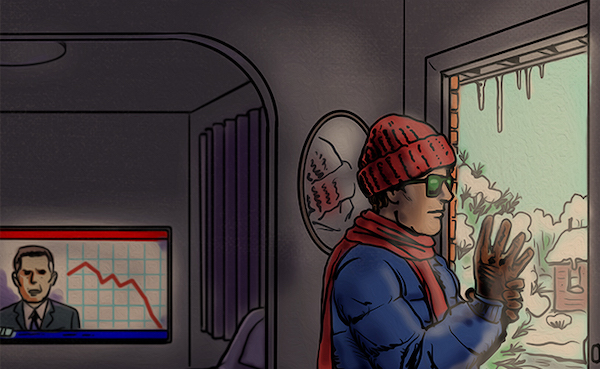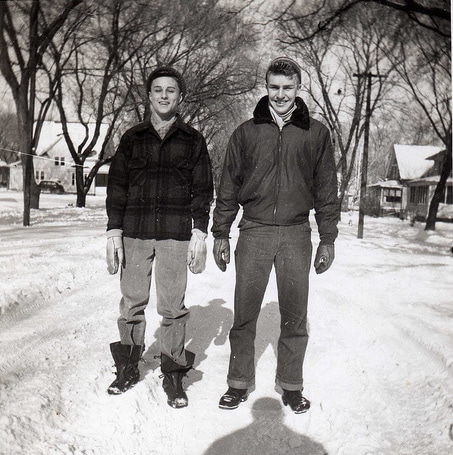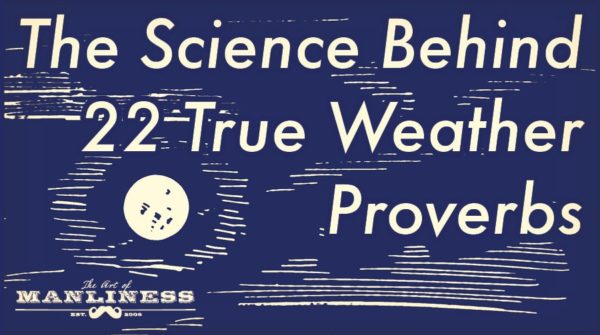
When you really think about it, the weather impacts our decisions every single day. What we wear, when we leave for our morning commute, the chores we do, the hobbies we partake in, the family activities we plan. And on and on the list goes of how our lives are influenced by the winds and skies.
Today, we have meteorologists and entire government agencies dedicated to predicting the weather with high-tech computers and algorithms, but a hundred and two-hundred years ago (and more!), folks had to rely mostly on observation and rudimentary tools to predict the weather of the coming days.
To help with this task of predicting the weather, farmers, sailors, and amateur meteorologists of all kinds came up with handy, often rhyming proverbs that could guide their observations. They realized that animal behavior, wind direction, air pressure (which could be measured with a barometer), etc., were pretty accurate indicators of how the weather would behave.
Perhaps surprisingly, most of this handed-down “folk wisdom” is really quite accurate, and has a lot of science behind it; weather proverbs of old can be applied today just as well as they were centuries ago. Rather than relying on your local meteorologist or your smartphone app to tell you what to wear for the day, why not work on your powers of observation and come to understand more about the weather and the natural world around you?
Note: I highly recommend first reading our article on air pressure and barometers; many of these proverbs are related to atmospheric pressure and how it relates to incoming and outgoing weather systems.
1. “If the goose honks high, fair weather. If the goose honks low, foul weather.”

This proverb has nothing to do with the pitch of a goose’s honk, but rather the altitude of its flight. If the goose “honks high” — or is flying at high altitude, it’s an indication of high barometric pressure, and therefore good weather. If it’s flying lower in the sky, barometric pressure is low, and poor weather is foretold. This is because geese are incredibly adept at flying with optimum air density. When air pressure is high, that optimum level is high in the sky, and the reverse is true for low pressure.
So, if geese are flying their V formations high up, get that picnic ready.
2. “When pipes smell stronger, it’s going to rain.”
To understand this proverb, we need to go to the molecular level. In dry air, aromatic or “smell” molecules (those that carry scent to our noses) are “naked” — they are floating around in the air on their own. In moist, humid air, water molecules attach to the aromatic molecules, and the scent becomes hydrated. This allows those smell molecules to better attach themselves to the moist surfaces of your nose, which makes their particular scent stronger.
When the air is moist like this, humidity is increasing, making rain more likely. So if your tobacco pipe has a stronger smell than usual, you might predict that poor weather is on its way. The same effect can be noted with lovely-smelling flowers (“Flowers smell best just before a rain”) and also offending manure fields and ponds (“Manure smells stronger before a rain” and “When ditches and ponds offend the nose, Look for rains and stormy blows”).
3. “If spiders are many and spinning their webs, the spell will soon be very dry.”
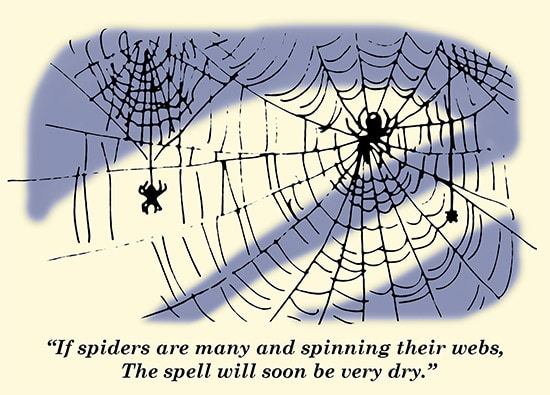
Spider webs are incredibly sensitive to moisture in the air. When humidity is high, their webs can absorb that water, making them heavy to the point of sometimes even breaking. Spiders are aware of this, so when they sense high humidity, they are most apt to stay in their hiding places. For humans, this is a sign that rain/poor weather is on its way. When they sense dry air (a sign of good weather), they’ll come out and spin their webs freely, knowing they have a few days of happy hunting.
4. “Red sky at night, sailor’s delight; red sky in morning, sailor’s warning.”
While this weather proverb (and its many variants) is probably the most well known in our culture, its truth is a little more complicated than is typically understood. This is because the proverb isn’t actually specific enough for us to accurately predict the weather.
A red sky at night can indeed mean fair weather, but particularly if the red appears in the eastern sky. A red night sky in the east likely means that the light of the setting sun is passing through the low atmosphere and reflecting off clouds. If this is the case, it’s possible that rain has already passed, and you’re in the clear.
A red western sky at night can mean a couple things, depending on the shade of red. A more pinkish hue can portend clear, fair weather, but a deep red sky at night to the west can mean that moisture is collecting in the air, and a storm system is forming.
The “red sky in morning” half of the proverb can be equally vexing.
Beyond just the atmospheric explanations, pollution and other unnatural particles in the air can drastically affect the color of the sky in all directions and all times of day.
So while you’ll find quick answers and explanations to the proverb online, a red sky can ultimately mean different things based on a variety of factors, both natural and not-so-natural. While it’s a quippy proverb, the others on this list will better help you predict the weather in the coming days.
5. “When dew is on the grass, rain will never come to pass.”
Dew forms when grass gets colder than the dew-point temperature (the temp at which dew forms). At night, grass cools when heat from the ground radiates upward. In a clear, dry atmosphere, this heat escapes the atmosphere and rises into outer space.
In a moist and humid atmosphere, water vapor absorbs some of that heat and can redirect it back down to the ground, warming up the grass, and thus keeping it dew free.
Dew on the grass is therefore a sign of a high pressure system, and good weather.
6. “Doors and drawers stick before a rain.”
Doors that stick in the frame upon opening or that are troublesome to close are indicators of high humidity, portending rain. There is a lengthy biological — specifically dendrological (the study of trees) — explanation for this, but for our purposes, just know that wood expands when the air humidifies. Humidity is a sign of low pressure and incoming poor weather, so when doors stick, look for showers.
7. “Frogs croaking in the lagoon, means rain will come real soon.”
As cold-blooded amphibians, frogs require moist skin and relatively high temperatures to be active. This means that their croaking implies that both temps and humidity are high (the water in the air keeps their skin moist). High humidity, as we’ve learned, is a sign of incoming rain.
8. “When clouds appear like rocks and towers, the Earth’s refreshed with frequent showers.”

This proverb references the foreboding visual characteristics of storm clouds — known as cumulonimbus clouds. These towering behemoths reach up to 75,000 feet in the sky, and before turning anvil-like, they appear as rocks being stacked upon each other. So when rocks and towers appear in the sky, expect storms.
9. “Mackerel skies and mares’ tails make tall ships carry low sails.”
“Mackerel” in this proverb is referring to altocumulus clouds, while “mares’ tails” is referring to cirrus clouds. Seeing these in the sky can mean a low pressure system is coming. In the immediate future (24 hours or so), you’ll see good weather. But the mackerels and mares’ tails are the first visible signs of an approaching warm front, which provides the ingredients for storms. As the system rolls in, the clouds will become thicker and thicker until the rain starts to fall.
So when a ship would see these signs, they’d lower the sails and batten down the hatches in preparation of incoming bad weather.
10. “A ring around the sun or moon, means that rain will come real soon.”
A ring around the sun or moon is caused by light from those bodies (light doesn’t come from the moon, but you get my drift…) passing through ice crystals in the upper atmosphere. These ice crystals have either been blown over the tops of high, approaching storm clouds, or from high cirrus clouds, which as we just learned, can be the first indication of an incoming low pressure system. So when you see a ring, prepare for precipitation.
11. “Rainbow in the morning sailor’s warning; rainbow at night sailor’s delight.”
This proverb is similar to the “Red sky at night…” one, but rather than looking at the sky as a whole, you’re focusing on a unique weather phenomenon: the rainbow. Since rainbows are always on the opposite side of us from the sun, they appear in the west in the morning, and the east in the evening. A rainbow will always be in the location of rain, so a morning rainbow means precipitation in the west (likely approaching your location), and an evening rainbow means precipitation in the east (likely heading away from your location). Since fair weather often follows a rain shower, night rainbows delight sailors.
12. “When the ass begins to bray, surely rain will come that day.”
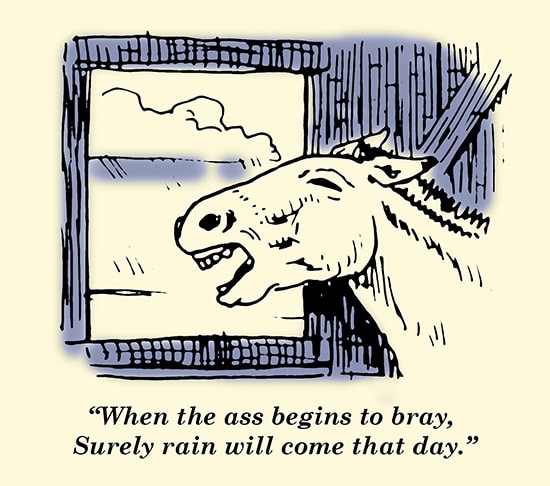
Advancing rain and storm systems are often first indicated by falling air pressure. Low pressure has been shown to make animals of all varieties more irritable and active. Dogs bark more, frogs croak, birds chirp, etc. The science is murky, but prevailing theories are that changes in air pressure are felt acutely by animals; humans sometimes feel cranky and out of sorts when a low pressure system blows in too, but an unstable atmosphere in general is better detected by our four-legged friends. So when the ass brays, and other creatures get a little feistier, know that poor weather may be coming.
13. “If the new moon holds the old moon in her lap, fair weather.”
Most of the time, it’s difficult to see the dark part of the moon during its new and crescent phases. This is because the air has a general state of turbulence — all kinds of molecules and particles banging into each other. In low pressure, poor weather systems, this is even more the case. During high pressure, fair weather systems though, the atmosphere clears up more than usual, and dim objects are easier seen by the human eye.
So, if you can see the dark part of the moon (that’s the meaning of the cryptic proverb), it means a high pressure system is making its way in, and you can expect good weather.
14. “When the wind is in the east, it’s good for neither man nor beast. When the wind is in the north, the old folk should not venture forth. When the wind is in the south, it blows the bait in the fishes’ mouth. When the wind is in the west, it is of all the winds the best.”

The general direction of the wind can be a great indicator of the type of weather moving in to your area. An easterly wind (meaning the wind is coming from the east, and blowing towards the west) means an approaching low pressure system, and poor weather. The barometer falls, which as we learned above, is good for neither man nor beast. A north wind brings the cold chill of the northern environs, a south wind brings warm (but humid) conditions, and western winds bring the fairest weather of all — mild temperatures and dry air.
15. “If the clouds move against the wind, rain will follow.”
When clouds are moving against the direction of the wind, it is often because of a phenomenon called wind shear, in which wind direction is different in the lower parts vs. upper parts of the atmosphere. This creates an unstable atmosphere, leading to rain and storms. In extreme scenarios, this is how hurricanes are formed.
16. “Rain before seven, clear before eleven.”
This proverb is actually more related to fog than rain, but it makes a handy little saying. The most common type of fog is called radiation fog, which occurs on clear, atmospherically stable nights. As we learned with the proverb about dew, heat from the ground radiates to outer space, cooling the ground to the dew-point temperature. This creates drew. As it cools even more, condensation is formed in the air through a process known as heat conduction. This occurrence is almost exclusively a nighttime and very early morning phenomenon.
In some cases, if the air has some turbulence, the fog can thicken and even produce rain. This isn’t rain from a low pressure system, though, meaning the vapor will soon be spent, and the rain will not last long. Hence, if there is rain early in the morning (before seven), it’s likely to clear off by lunchtime.
Note that this is only accurate for this type of fog-related shower. If it’s a true low pressure system, the rule does not apply.
17. “The sharper the blast the sooner ‘tis past.”
When a storm builds rapidly, it’s often stronger and faster than when a storm builds gradually. A strong thunderstorm has an average speed of about 30 miles per hour, meaning it will generally only last a few hours. A gentle rain shower, though, can travel at a fraction of that speed, and can last for a few days.
18. “The ash before the oak, choke, choke, choke, the oak before the ash, splash, splash, splash.”
This proverb is more of a long-range predictor than the others in this list. The “ash before the oak” refers to budding; the “splash” refers to wet weather. If ash trees bud before oak trees, expect a drier summer; if the reverse, expect a wetter summer.
The timing of when trees bud is related to the moisture content of the soil. A dry fall and winter means little moisture in the topsoil, but there could still be moisture deeper within. A wet fall and winter means a moist topsoil, which leads to a quick budding for ash trees because of their shallow root system. If previous seasons have been dry, an oak’s deep root system will tap into the deeper parts of the soil, and bud before the ash.
How does this relate to a long-term weather prediction? It’s based on the simple theory of mother nature trying to maintain balance and average precipitation. Dry seasons are generally followed by wet seasons, and vice versa.
19. “When your joints all start to ache, rainy weather is at stake.”
This proverb is related to the one above about the ass braying, but is more directly pointing to joint pain in humans. Did you have an old uncle whose bad knee could predict a storm? While there has been more research done on how weather affects humans than there has been on animals, it’s all still just theory.
The hypothesis that is most supported by the scientific community is that low pressure (meaning less force on your body/joints) allows tissue to expand, which can put pressure on your joints. So when your bum knee aches a little more for seemingly no reason, look to the skies and prepare for rain in the next day or so.
20. “When the glass falls low, prepare for a blow; when the glass is high, let your kites fly.”

This is a simple proverb about watching and reading barometric pressure. In the early days of this weather gauge, it was called a “glass” (because a glass tube housed the mercury). When the “glass” is low — that is, when the mercury is low, meaning low pressure — you can expect rain and generally poor weather. When the mercury is high, a high pressure system is in (or coming in), and fair weather can be enjoyed.
21. “The moon, her face be red, of water she speaks.”
The color of the moon — particularly when it’s full and rising — can be an indicator of incoming weather systems. In a dry atmosphere (indicating good weather), the moon is seen as white. When the atmosphere begins to collect moisture, molecules in the air scatter light differently than in a dry atmosphere, and the moon appears redder.
This moisture that is making the moon look red can be a sign of rising humidity, meaning coming rain showers.
22. “Long foretold, long last, short notice, soon passed.”
A weather system with gradual changes is more likely to stick around for a while than a weather system that moves and changes quickly. A shower or storm that only lasts a few minutes or hours is the result of dramatic changes in air pressure and temperature, which aren’t able to be forecasted with any real accuracy. If pressure and temperature changes happen slowly, however, it’s very likely that the weather system will stick around longer. These are also far more likely to be accurately predicted by meteorologists; slow-moving systems with gradual changes are obviously easier to read.
Be sure to our podcast about how to develop your nature instinct:


